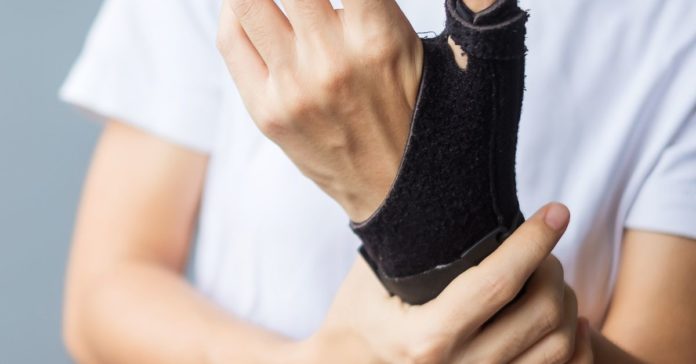Overview
A tendon is a kind of fibrous tissue that connects the body’s muscles to the bones. A protective sheath called the synovium covers the tendons and produces synovial fluid that keeps the tendon lubricated.
Injury to the tendon can result in malfunction of the sheath. The inflammation or swelling of the sheath is known as tendon sheath inflammation or tenosynovitis.
This blog is a comprehensive guide to tenosynovitis, its symptoms, causes, and treatment methods.
What are the symptoms of tenosynovitis?
Some of the common symptoms of tenosynovitis include:
- An inflamed thumb
- Pain and tenderness in the thumb area.
- Excessive pain that develops over time or suddenly occurs.
- Difficulty in grasping or pinching objects.
- Popping sensation while moving the thumb
When to see a doctor?
If a patient finds it difficult to move the arms or wrists, it is advisable to avoid using the painful area for a few days. If placed over the wrist, an ice pack may help relieve pain.
One must consult a doctor if the pain and swelling persist for days, even after taking a rest.
What are the causes of Tenosynovitis?
Tenosynovitis is usually the result of injury to the tendon or surrounding muscle or bone. It is not limited to athletes and appears in people who perform various repetitive-motion activities, such as carpenters, dentists, musicians etc. It is seen most commonly in the tendons of the hands, wrist and feet. Injury might result from:
- Sudden sprains and strains
- Repetitive-stress activities
- Prolonged physical activities like running
- Standing in the same position for longer period
Inflammation in the tendon sheath can also be due to underlying health conditions like
- Gout
- Diabetes
- Rheumatoid arthritis
- Scleroderma
- Reactive arthritis like Reiter’s syndrome
- Gonorrhea
What are the complications of Tenosynovitis?
Tenosynovitis causes intense pain, swelling, and stiffness. It may even lead to difficulty in moving the affected area . Early medical intervention is necessary to keep the condition under control.
What is De Quervain’s tenosynovitis?
De Quervain’s tenosynovitis is an illness that affects specific tendons of the thumb. It is a painful condition, and the pain may extend from the base of the thumb to the forearm. Jobs or activities that demand repeated motion of the hand or wrist or arthritis can cause swelling of the tendon. It causes pain and restricts the movement of the hand and wrist.
What are the treatment methods to handle Tenosynovitis?
The primary step in treating tenosynovitis is getting enough rest to help the person reduce inflammation and pain. Splints coul;d be immobilise the area. The healthcare provider may recommend wearing it for four to six weeks to give the affected part complete rest.
Ice packs may be placed over the affected area regularly until the swelling and pain are under control. It is better to avoid activities that may cause pain. Doctors may also recommend anti-inflammatory medications or injections to cure the condition.
If the medications fail, doctors may recommend surgery for tenosynovitis. It is an outpatient procedure completed under local anaesthesia. A tiny cut through the sheath will give more room for tendons to move without difficulty. A c physiotherapist may suggest exercises to regain strength and fasten the recovery.
What are the ways to prevent tenosynovitis?
Since the cause of tenosynovitis is unclear, there are no specific aspects of prevention. However, following some of the below-mentioned steps may help.
- Refrain from doing the same work or staying in the same position for too long. Whatever jon you do, such as writing, sitting, playing the piano, typing, or any such work, do take a break and move around every 30 minutes.
- Safe weight lifting methods are necessary to avoid injury while lifting heavyweights. Never lift heavy objects with a single hand. Use a firm grip, lean down, and ensure that there is equal pressure on both sides of the body.
- Athletes and sportspeople need to follow a proper warm-up and cool-down routine before and after the workout. People who do home workouts should also adhere to this.
Conclusion
The patient would notice signs of pain and swelling in the early stage. If the discomfort persists, the patient should seek immediate medical intervention.
Frequently Asked Questions (FAQs)
Who is more prone to tenosynovitis: men or women?
Some studies report that women are eight times more prone to tenosynovitis than men.
What test can diagnose tenosynovitis?
Diagnosis of tenosynovitis will need a physical examination of the affected region. The treating doctor will check to see if swelling and redness are present. In certain cases, the doctor might order an MRI scan or ultrasound to confirm a diagnosis or rule out other possible causes like arthritis.
Is physiotherapy a necessary treatment after the surgery for tenosynovitis?
Surgery helps to create room for the tendons to move through the sheath. Physiotherapy recommended by a certified therapist will help the patient recover faster and regain strength and agility.


















